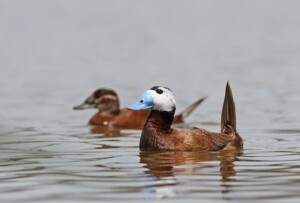Changes to the British List (15 Sept 2023)
The British Ornithologists’ Union Records Committee (BOURC) has considered the following with regard to the British List.
 White-headed Duck Oxyura leucocephala Category D status
White-headed Duck Oxyura leucocephala Category D status
Photo (right) Bouke ten Cate, CC BY-SA 4.0 Wikimedia Commons
The status of White-headed Duck on the British List has been reconsidered as the species resides on Category D, where ‘there is reasonable doubt that they have occurred in Britain in a natural state’; such categorisation is reviewed periodically as part of BOURC procedure (Ibis 164: 860-910).
A thorough and protracted analysis of British records was undertaken, with the pattern and incidence of these records compared with that in other Western European countries where some extra-limital records have been deemed to be of wild origin.
The BOURC analysis revealed no obvious link between the temporal pattern of British records and the expected pattern of occurrences of birds on the continent, principally in France and the Netherlands. This means that the alternative parsimonious explanation that at least some of the British records relate instead to wandering and long-staying escape captive birds remained difficult to refute, despite the status of the species as a likely vagrant. Though the Committee agreed that the British records were likely a mixture of wild and escaped captive birds, a consensus on identifying an individual bird that was wild was not achieved. Hence, the final BOURC vote on the status of White-headed Duck on the British List was split, with six for retention on Category D and four for Category A. Following BOURC procedures this majority vote resulted in a decision for Category D, with White-headed Duck therefore remaining with this categorisation.
A paper describing in detail the BOURC process that resulted in this conclusion will be prepared for submission to British Birds.
This decision will be published as part of the BOURC’s 56th report due to be published in Ibis in January 2024. Upon publication of this decision, the British List remains at 631 species (Category A = 613; Category B = 8; Category C = 10).

